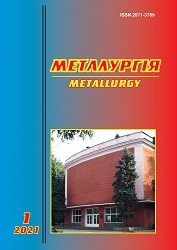EXPERIMENTAL AND CALCULATION RESEARCH OF CARBONATING FOR LOW-DENSITY CARBON COMPOSITES AT THERMO-CHEMICAL TREASON OF THERE COMPONENTS
Abstract
During carbonating of carbon composites there are difficult physical and chemical transformations to the volume of polymeric matrix and pores-forming with formation of coke remain, and also secreting of gaseous volatiles of different chemical composition. It is set, that volumetric and linear contractions of phenol-formaldehyde resin during carbonating have three characteristic temperature in-tervals. During carbonating of resin to temperature 673 K there is an insignificant increase of values of contraction, with the increase of temperature to 873 K the sharp increase of its values is fixed, and at the subsequent increase of temperature to 1073 K the change of contraction has more smooth character. Results of determination of the modules of elasticity of fibred materials and made foam powder of phenol-formaldehyde resin are showed, that its size with the increase of temperature gradually diminishes and at temperature 1200 K has a permanent and minimum size practically. Experiments by determination of strength descriptions of components of suspension allowed to ascertain that with increase of temperature the gradual lowering of the there descriptions of components suspensions which at a temperature 1273 T become sufficient for providing of durability of eventual material. The change of contraction for low-density carbon composites is conditioned by thermochemical transformations, what be going on with its components in the process of carbonating. To the temperature 500 T there are changes in pore-forming materials with a further increase temperatures begin to be distinguished gaseous matters are a result of transformation of matrix material (phenol-formaldehyde resin) in the polymer of the reticulated structure. Durability of composites in the process of carbonating sharply changes at a temperature higher 400 T and arrives at the maximal value ~ 1.2 МПа at a temperature 900 К.
References
2. Бушуев Ю.Г., Персин М.И., Соколов В.А. Углерод-углеродные композиционные материалы : справочник. Москва : Металлургия, 1994. 128 с.
3. Мелешко А.И., Половников С.П. Углерод, углеродные волокна, углеродные композиты. Москва : САЙНС-ПРЕСС, 2007. 192 с.
4. Карпенко А.В. Научные основы получения низкоплотных материалов методом разлива из водных суспензий. Специальные вопросы химии и химической технологии. 2006. № 5. С. 138–142.
5. Волков С.Д., Ставров В.П. Статистическая механика композитных материалов. Минск : БГУ, 1978. 206 с.
6. Соколкин Ю.В., Скачков В.А., Танкеева М.Г. Исследование процессов деформирования и разрушения композитных материалов и конструкций при сложном нагруженном состоянии. Механика конструкций из композиционных материалов. Новосибирск : Наука, 1984. С. 97–101.
7. Скачков В.О., Карпенко Г.В., Грицай В.П., Іванов В.І., Карпенко Н.О. Моделювання процесу карбонізації вуглецевих композиційних матеріалів з утворювачами пор. Металургія. Наукові праці ЗДІА, 2005. Вип. 12. С. 80–86.
8. Скачков В.А., Карпенко В.Д., Карпенко А.В., Нестеренко Т.Н. Моделирование процесов сокарбонизации углеродных композиционных материалов с порообразователям : материалы и покрытия в эктремальных условиях: исследования, применение, экологически чистые технологи производства и утилизации изделий. Труды конференции. Кацивели-Понизовка, 13-17.09.2004. С. 61.
9. Скачков В.А., Карпенко А.В., Грицай В.П., Печенникова В.М. Изменение свойств углеродных композитов с порообразователями в процессе карбонизации. Оборудование и технологии термической обработки металлов и сплавов : сб. докладов 6-й Межд. конф. Харьков, 2005. С. 75–76.
10. Карпенко А.В., Скачков В.А., Фильченков А.С. Модель процесса карбонизации углерод-углеродного композиционного материала. Компьютерне моделювання в хімії та технологіях. Тези доп. Черкаси, 2008. С. 169–170.

 ISSN
ISSN 


